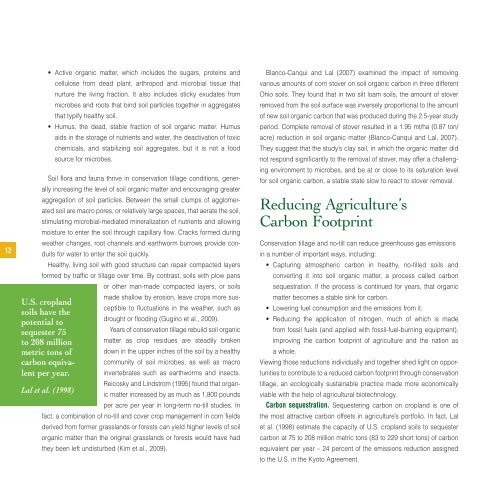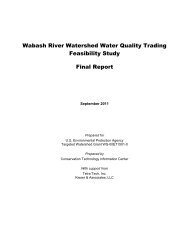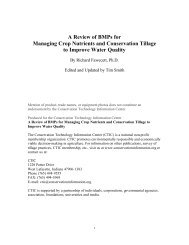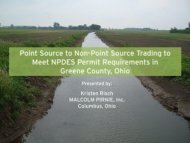Facilitating Conservation Farming Practices and Enhancing ...
Facilitating Conservation Farming Practices and Enhancing ...
Facilitating Conservation Farming Practices and Enhancing ...
You also want an ePaper? Increase the reach of your titles
YUMPU automatically turns print PDFs into web optimized ePapers that Google loves.
12<br />
• Active organic matter, which includes the sugars, proteins <strong>and</strong><br />
cellulose from dead plant, arthropod <strong>and</strong> microbial tissue that<br />
nurture the living fraction. It also includes sticky exudates from<br />
microbes <strong>and</strong> roots that bind soil particles together in aggregates<br />
that typify healthy soil.<br />
• Humus, the dead, stable fraction of soil organic matter. Humus<br />
aids in the storage of nutrients <strong>and</strong> water, the deactivation of toxic<br />
chemicals, <strong>and</strong> stabilizing soil aggregates, but it is not a food<br />
source for microbes.<br />
Soil flora <strong>and</strong> fauna thrive in conservation tillage conditions, generally<br />
increasing the level of soil organic matter <strong>and</strong> encouraging greater<br />
aggregation of soil particles. Between the small clumps of agglomerated<br />
soil are macro pores, or relatively large spaces, that aerate the soil,<br />
stimulating microbial-mediated mineralization of nutrients <strong>and</strong> allowing<br />
moisture to enter the soil through capillary flow. Cracks formed during<br />
weather changes, root channels <strong>and</strong> earthworm burrows provide conduits<br />
for water to enter the soil quickly.<br />
Healthy, living soil with good structure can repair compacted layers<br />
formed by traffic or tillage over time. By contrast, soils with plow pans<br />
or other man-made compacted layers, or soils<br />
made shallow by erosion, leave crops more susceptible<br />
to fluctuations in the weather, such as<br />
U.S. cropl<strong>and</strong><br />
soils have the<br />
drought or flooding (Gugino et al., 2009).<br />
potential to<br />
sequester 75<br />
Years of conservation tillage rebuild soil organic<br />
to 208 million<br />
matter as crop residues are steadily broken<br />
metric tons of<br />
down in the upper inches of the soil by a healthy<br />
carbon equivalent<br />
per year.<br />
invertebrates such as earthworms <strong>and</strong> insects.<br />
community of soil microbes, as well as macro<br />
Reicosky <strong>and</strong> Lindstrom (1995) found that organic<br />
matter increased by as much as 1,800 pounds<br />
Lal et al. (1998)<br />
per acre per year in long-term no-till studies. In<br />
fact, a combination of no-till <strong>and</strong> cover crop management in corn fields<br />
derived from former grassl<strong>and</strong>s or forests can yield higher levels of soil<br />
organic matter than the original grassl<strong>and</strong>s or forests would have had<br />
they been left undisturbed (Kim et al., 2009).<br />
Blanco-Canqui <strong>and</strong> Lal (2007) examined the impact of removing<br />
various amounts of corn stover on soil organic carbon in three different<br />
Ohio soils. They found that in two silt loam soils, the amount of stover<br />
removed from the soil surface was inversely proportional to the amount<br />
of new soil organic carbon that was produced during the 2.5-year study<br />
period. Complete removal of stover resulted in a 1.95 mt/ha (0.87 ton/<br />
acre) reduction in soil organic matter (Blanco-Canqui <strong>and</strong> Lal, 2007).<br />
They suggest that the study’s clay soil, in which the organic matter did<br />
not respond significantly to the removal of stover, may offer a challenging<br />
environment to microbes, <strong>and</strong> be at or close to its saturation level<br />
for soil organic carbon, a stable state slow to react to stover removal.<br />
Reducing Agriculture’s<br />
Carbon Footprint<br />
<strong>Conservation</strong> tillage <strong>and</strong> no-till can reduce greenhouse gas emissions<br />
in a number of important ways, including:<br />
• Capturing atmospheric carbon in healthy, no-tilled soils <strong>and</strong><br />
converting it into soil organic matter, a process called carbon<br />
sequestration. If the process is continued for years, that organic<br />
matter becomes a stable sink for carbon.<br />
• Lowering fuel consumption <strong>and</strong> the emissions from it.<br />
• Reducing the application of nitrogen, much of which is made<br />
from fossil fuels (<strong>and</strong> applied with fossil-fuel-burning equipment),<br />
improving the carbon footprint of agriculture <strong>and</strong> the nation as<br />
a whole.<br />
Viewing those reductions individually <strong>and</strong> together shed light on opportunities<br />
to contribute to a reduced carbon footprint through conservation<br />
tillage, an ecologically sustainable practice made more economically<br />
viable with the help of agricultural biotechnology.<br />
Carbon sequestration. Sequestering carbon on cropl<strong>and</strong> is one of<br />
the most attractive carbon offsets in agriculture’s portfolio. In fact, Lal<br />
et al. (1998) estimate the capacity of U.S. cropl<strong>and</strong> soils to sequester<br />
carbon at 75 to 208 million metric tons (83 to 229 short tons) of carbon<br />
equivalent per year – 24 percent of the emissions reduction assigned<br />
to the U.S. in the Kyoto Agreement.








